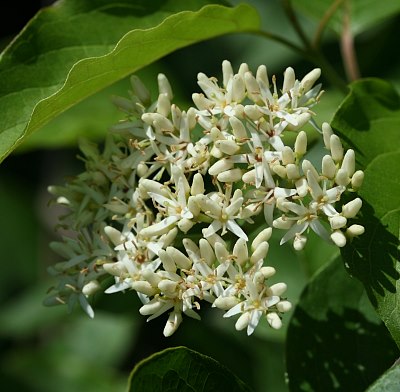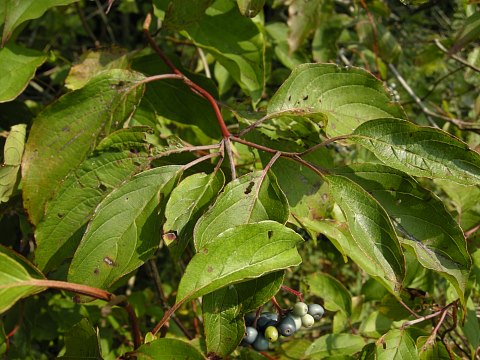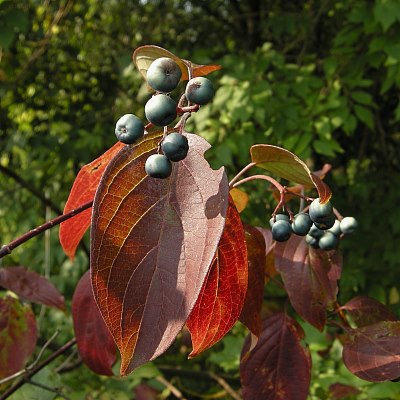Description: This woody shrub is 8-15' tall; it has a rounded shape and branches frequently. The bark of the trunk and larger branches is gray, while smaller branches are brown and smooth. Young twigs are hairless and red, becoming dark reddish brown with age. The pith of the twigs is white. The opposite leaves are up to 3½" long and 2" across; they are ovate to ovate-lanceolate and smooth along their margins. Upper leaf surfaces are medium to dark green and hairless, while lower leaf surfaces are a slightly lighter shade of green and hairless to nearly hairless. The slender petioles of the leaves are up to 1" long and hairless to nearly hairless. Like the leaves of other Cornus spp. (Dogwoods), the lateral veins of the leaves curve away from the petioles. Young branches bear compound cymes (or flat-headed panicles) of white flowers about 1½–3" across. The stalks of each cyme are hairless. Each flower has 4 white petals, a tubular green calyx with 4 tiny teeth, 4 stamens, and a pistil with a central style. The petals are linear-lanceolate in shape. The flowers have an unpleasant odor. The blooming period occurs during late spring to early summer and lasts about 2-3 weeks. The flowers are replaced by 2-seeded fleshy drupes. At maturity, each drupe is about ¼" across and it is pale blue to blue. Each large seed (stone) is globoid in shape and fairly smooth. The root system consists of woody branching taproot; vegetative offsets are sometimes produced from underground runners. During the fall, the leaves assume attractive red-burgundy to purple colors.

Cultivation: Stiff Dogwood prefers light shade to full sun, wet to mesic conditions, and a loamy soil containing organic material.
Range & Habitat: The native Stiff Dogwood is uncommon in the southern half of Illinois, and absent in the upper half of the state (see Distribution Map). It is possible that this dogwood is more common than official records indicate because it can be easily confused with similar species. Habitats include low woodlands, damp thickets, low areas along streams, and swamps. This dogwood prefers moist partially shaded areas.

Faunal Associations: The nectar and pollen of the flowers attract a wide variety of insects, including long-tongued bees, short-tongued bees, wasps, flies, butterflies, skippers, and beetles. An Andrenid bee, Andrena fragilis, is a specialist pollinator (oligolege) of Cornus spp. (dogwood shrubs). Many insects feed on the foliage, wood, and other parts of dogwood shrubs. This includes such species as the larvae of long-horned beetles, leaf beetles, weevils, larvae of gall flies, plant bugs, aphids, leafhoppers, armored scales, mealybugs, larvae of sawflies, larvae of many moths, larvae of a butterfly, Celastrina ladon (Spring Azure), and thrips. Two of these insects, Plagiognathus cornicola and Aphis cornifoliae, have been observed to feed on Cornus foemina (Stiff Dogwood); see Knight (1941) and Thomas (1877). The Insect Table provides a more complete list of these species. Vertebrate animals also use these shrubs for food. Many species of birds, including wood ducks, grosbeaks, thrushes, vireos, upland gamebirds, woodpeckers, and some sparrows feed avidly on their fruits (see Bird Table). The fruits of dogwood shrubs are also eaten by the American Black Bear, White-footed Mouse, and Fox Squirrel. White-tailed Deer browse occasionally on their twigs and foliage, while the Cottontail Rabbit gnaws on their bark during the winter. When these shrubs grow near bodies of water, their wood and bark are eaten by the American Beaver, while their branches are sometimes used in the construction of this mammal's dams and lodges.

Photographic Location: A shrubby area of Meadowbrook Park that is near an intermittent stream.
Comments: For some strange reason, Stiff Dogwood has received less attention than other dogwoods (Cornus spp.), even though it is reasonably attractive and probably easy to grow. This species differs from other dogwoods by its pale blue to blue drupes, hairless or nearly hairless leaves that are green on both sides, and hairless red twigs with white pith. In many ways, it resembles the better-known Red-Osier Dogwood (Cornus sericea), except the latter species has white drupes and a more northern distribution. Another species with blue drupes, Cornus obliqua (Silky Dogwood), has more slender leaves that are whitened on their undersides from fine hairs. Yet another species with blue drupes, Cornus amomum (Swamp Dogwood), has leaves with brownish hairs on their undersides and its twigs have brown pith. This latter species is restricted to the southern tip of Illinois. A scientific synonym of Stiff Dogwood is Cornus stricta.